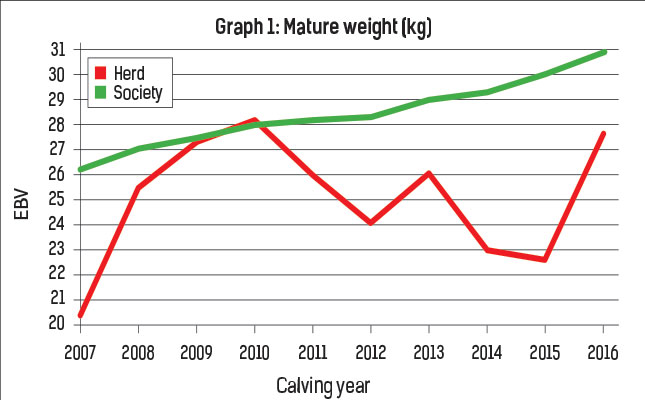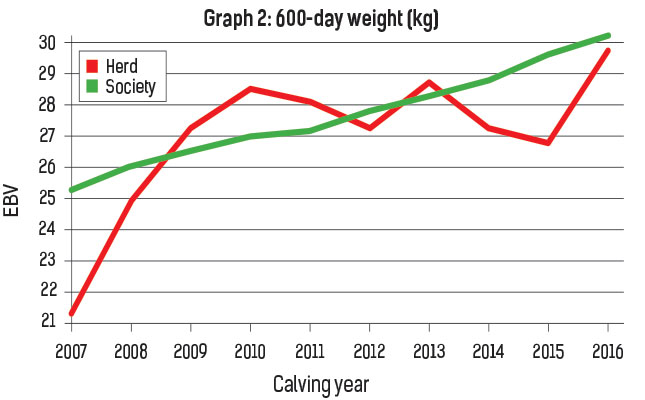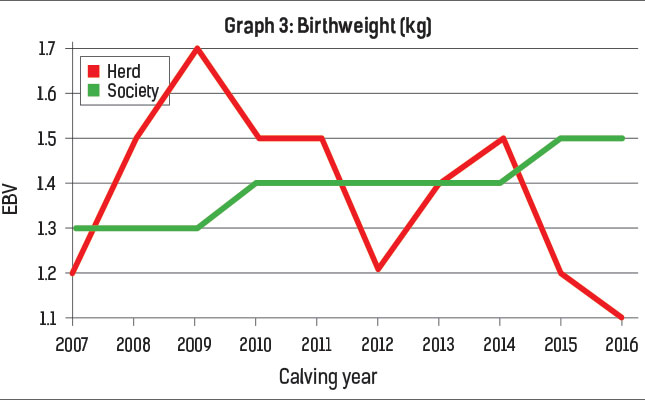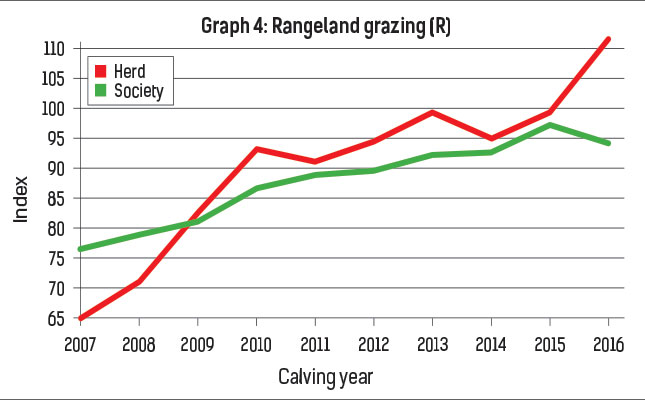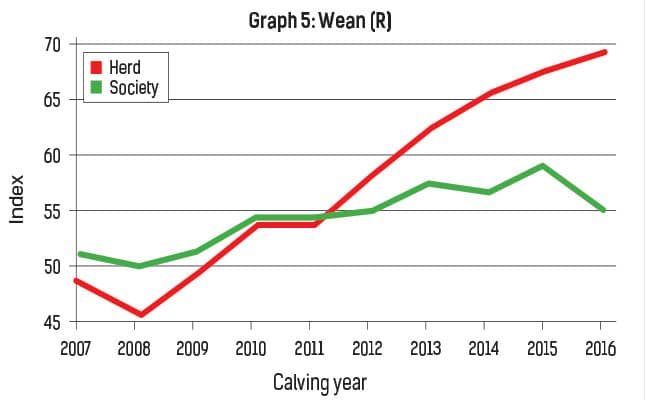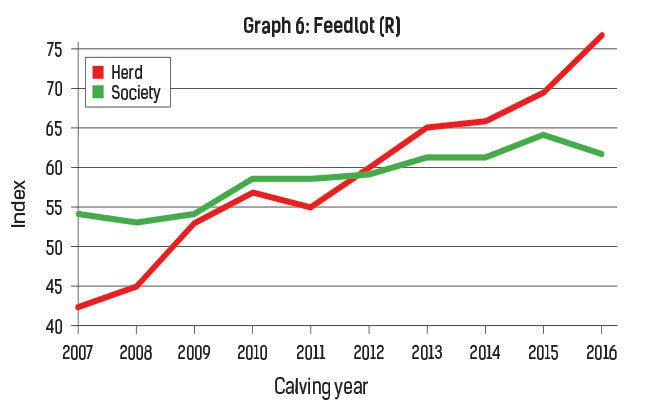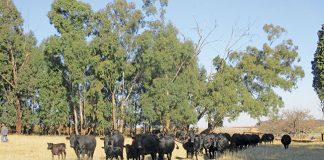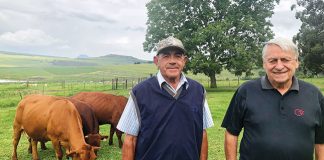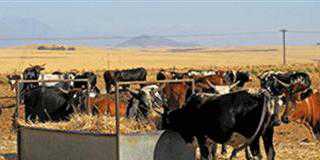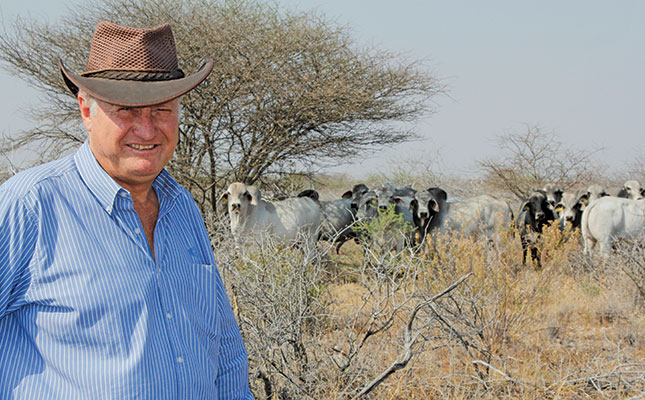
Photo: Wayne Southwood
Mecki and Brigitte Schneider manage a large-scale farming operation based mostly in the Grootfontein and Okahandja districts in Namibia. The home farm, Okamutombe, near Grootfontein, has been in the Schneider family for 103 years, with Mecki the third generation to run the farm.
The Schneiders run a Grey Brahman stud herd of more than 1 000 animals, a smaller Simmentaler stud herd and a large commercial beef herd. They breed a Manso type Grey Brahman and built the stud using top genetics from famous herds in the US, South Africa and Australia.
“It’s important to be linked to the commercial sector and not only the stud industry,” Mecki explains. “A stud breeder must breed what the commercial sector wants and what is relevant to it. There’s no point in breeding classy show winners when the market needs profitable and productive breeding stock.
“We’re living in very challenging times, with the worst drought in 50 years. It’s not going well economically in the livestock industry. The meat price is stagnant and input costs are skyrocketing. Research shows that cattlemen have to be 8% more efficient every year, which means 80% more efficient than 10 years ago for the same profit margin.”
Mecki has used the Breedplan and Herd Master programme for more than 15 years. After expanding the gene pool and their Brahman herd, the Schneiders concentrated on estimated breeding values (EBVs) from 2007 onwards to effect change, with very positive results.
The herd’s vast genetic improvement resulted in some of the older, previously top-performing cows relegated to the bottom of the list.
The breed
“We’ve found that Brahman and Brahman crosses are well adapted to the warm, dry conditions in Namibia,” he says. “The Namibian national herd is infused with about 70% Brahman genetics. The main characteristics that make the Brahman so popular are its hybrid vigour, maternal qualities, tick and heat resistance, and hardiness. It can range far when grazing and efficiently converts low-quality forage to beef.”
Apart from being used in the commercial beef sector, the Brahman is increasingly popular in communal farming areas, where it is used to improve local herds. It is found in all environments in Namibia, from the north-western mountainous region and north-eastern Zambezi region to the sand dunes in the west and the very arid and hot south.
Together with partners, the Schneiders also run the first registered Brahman stud herd in Angola, 300km east of Luanda.
Mecki explains that mature cow weights vary significantly according to available forage; some of his young cows weigh about 340kg each and older cows can weigh as much as 700kg. At birth, bull and heifer calves average 33kg and 30kg respectively. Weaners average just below 50% of their dams’ weight. He emphasises that the
At birth, bull and heifer calves average 33kg and 30kg respectively. Weaners average just below 50% of their dams’ weight. He emphasises that the intercalving period (ICP) is management-influenced and is not the best expression of fertility. On the other hand, days-to-calving is a genetic trait that will soon be available as an EBV and will prove highly valuable to the beef industry.
Breeding policy
All herds are run on a breeding season of less than 90 days. The first (summer) season is from the first week of January to the first week of April, and the second (winter) season is from late June to late August.
This focuses on strong, contemporary groups and enables the Schneiders to evaluate genetic traits and determine breeding values more accurately.
Mecki considers it important for a cow to have a condition score of at least five out of nine to cycle and conceive without problems.
The cow groups and bulls are changed every breeding season. Each year, a different bull services most of the cows to strengthen the genetic linkages and increase the accuracy of the calculated EBVs. Mecki runs between 30 and 45 cows per bull, depending on its age and ability.
He does not chase extremes; the most important traits bred for are the following:
- Low birthweight EBVs: Under extensive conditions, cattlemen want easy calving in the veld at birthweights of between 30kg and 35kg.
- Average to above-average growth traits: Typically, bulls with higher birthweight EBVs grow faster. But a small percentage of bulls, the gems the Schneiders are looking for, combine low birthweights with high growth rates.
- Low mature cow weight EBVs: In an extensive environment, medium-framed cows need less forage to maintain themselves and produce good growers.
- Scrotal size and days-to-calving: Both of these fertility traits are important.
- Key carcass traits: Weight, rib-eye muscle area (with a direct link to the muscling of the animal), rib and rump fat, and intra-muscular fat EBVs are important indicators of market readiness in early maturing cattle-types. These traits also help identify replacement heifers that will cycle and be fertile at an early age. All these carcass traits are far above average in the Schneiders’ herd.
Appoximately 50 heifers are selected and artificially inseminated every breeding season to bring new genetics into the herd. Heifers are easier to manage and genetic progress is much faster with younger animals.
Mecki and his team spot heat and inseminate the heifers eight to 12 hours after standing heat. He has often used semen from the US, and is now also importing semen from Australia. Most bulls used in the herd are the Schneiders’ own animals, however, so extra care is taken to keep the genetic lines as far apart as possible.
Mecki has flushed embryos from top cows in the past and when the drought ends, will do so again. The Schneiders are also in the process of establishing an internationally approved semen and embryo centre to export genetics into Africa and, eventually, other continents.
Forcing change
“To change the average of certain traits in a large herd, select bulls that are strong on these traits,” Mecki recommends. “However, selecting and maintaining such a strong bull-power battery is a challenge on its own.
“Changing the genetic direction in a small herd is like turning a speedboat, whereas changing the direction in a 700-strong cow herd is akin to turning a huge oil tanker. It takes time, but it’s essential to improve efficiency every year. Without adequate, accurate data, this would be impossible.”
Over the years, the Schneiders have forced the average mature cow weight down (see graph 1).
Birthweight is now below the breed average, and 200- day, 400-day and 600- day weights are at the breed average (see graphs 2 and 3).
A key aspect of a specific sire is the profitability it can add to the herd. This is captured in the concept of selection indices, which are an evaluation of EBVs under a specific production system, producing for a specific market. The three economic selection indices for Brahmans (expressed as a net rand value difference in profitability per cow mated [R]) are:
- The rangeland grazing index, for producing slaughter steers with a 250kg carcass weight at 30 months on the veld (see graph 4);
- The wean index, for producing high-quality weaners efficiently (see graph 5);
- The feedlot index, for producing high-quality carcasses for the feedlot environment (see graph 6).
- The profitability trends of the Okabra Brahman herd’s genetics are reflected in the rangeland, feedlot and weaning indices, which are a combination of all EBVs including growth, fertility and carcass EBVs. The Schneiders’ strong focus on specific, important breeding values a decade ago has resulted in a distinct improvement in herd profitability above that of the current breed average (see graphs 1 to 6).
The cow herd
The Schneiders use an Excel spreadsheet to provide an overview of each cow’s traits, using different colours to indicate the desirability of each trait, from dark red (undesirable) to dark green (highly desirable). Apart from focusing on the EBVs and other traits, they evaluate specific structural traits as summarised in a point score from one to nine:
- Navel skin: correlated to sheath length in sons.
- Udders and teats: their condition should ensure strong-sucking calves after birth.
- Temperament: a docile animal is preferred, although cows are expected to defend their calves against predators.
- General structural soundness.
The spreadsheets show that the younger the female, the more prominent the green colour for all traits.
Mecki plans to semi-retire in a few years. His son, Reimo, and wife, Sonja, will take over the farm, assisted by farm manager, Alex de Koning.
Email Mecki Schneider at [email protected], or phone +264 (0) 811292623.

